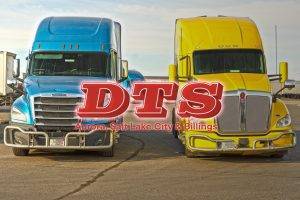A recent report put out by the American Trucking Associations says that over 70 percent of goods consumed in the U.S. are moved by truck. Additionally, while the industry has already seen an increase of 2.8% over the past year, the amount of freight being hauled by trucks is expected to increase more than 3% annually over the next five years.
An increase in the shipping economy means that even though the available trucker pool has dwindled, those who are qualified are in more demand than ever. The industry needs to hire close to 900,000 more drivers over the next ten years to meet rising demand. Without qualified drivers to operate the growing fleets of trucking companies, capacity will remain constrained and freight transportation rates will remain high or even increase.
Today, trucking companies are struggling to find qualified drivers in need of a job. Unemployment is down to 4.1 percent, and the U.S. is nearing what specialists consider “full employment,” meaning that just about anyone who wants to find a job can find one.
Why are qualified drivers so hard to come by?
- An aging fleet of drivers is one of the top reasons for the driver shortage. The Bureau of Labor Statistics estimates that, “[…] the average age of a commercial truck driver in the U.S. is 55 years old.”
- While many trucking companies have optimized recruiting practices to attract younger drivers, the qualified members of the younger market are choosing driving jobs that keep them close to home.
- Many freight carriers, despite being short-handed on truck drivers, are selective in hiring drivers because they have made safety and skilledism high priorities. Most insurance companies have strict requirements, such as clean driving records and previous experience.
- The improving U.S. economy, plus damages caused by 2017s extreme weather, have resulted in a growing construction industry. This temporary surge in demand for seasonal labor has lured many qualified drivers away from trucking by offering higher wages and shorter days – but only during construction season.
Why drive?
Because who doesn’t love the freedom of the open road, right? You, a furry companion, your favorite music, quaint towns, and hidden truck stop treasures. It’s the start of a novel, or a nostalgic bluegrass song.
Truck drivers, whether over-the-road or regional, get to see the country and all the beauty it holds. From the rural towns of middle America to the bright lights of cities along the coast. From mountains to oceans, truck drivers have a chance to see the best this country has to offer (sometimes in a single trip). In many ways, America’s truckers are our modern-day explorers.
Probably one of the most common reasons to get into trucking, is the independence that goes along with the nature of the job. There’s no boss hanging over your shoulder and no fellow employees bumping elbows with you all day.
I think it’s important to mention, too, that trucking today isn’t what it was for our parents’ or grandparents’ generations. Trucks are much more efficient today, and you no longer need some of the brawn previously needed to maneuver these massive vehicles. Autonomous technologies help make driving easier and safer than ever, and technologies such as weather tracking and location mapping give everyone a leg up on what’s next. Plus, sleeper cabs have had some major upgrades lately, with thousands upon thousands of accessories to accommodate all your needs, from TVs to toilets.
With a job as a truck driver, you can sleep easy knowing you have job security. The trucking industry is a secure market. You will always have a position available to you. Even if things were to slow down, there is always a need for drivers.
Now, let’s talk about the bottom line
Everyone needs money, and often the more of it the better. If you’re tired of just barely making it on a minimum wage salary, truck driving may be the perfect fit for you.
- You could make over $45,000 in your first year as a solo OTR truck driver. Team drivers can make an average of $60,000 to $65,000 a year. Drivers who become owner-operators can make over $100,000 a year!
- Benefits for truck drivers can include medical, dental, life insurance, vision, and retirement plans. Most companies are giving bonuses and increased pay for truck drivers, particularly long-haul drivers, rewarding safety and experience.
- Pay in the industry has come up considerably; up almost seventeen percent over the last couple of years. Truckers today can earn more for a starting wage than many college graduates.
How to get your CDL
The requirements to get a CDL can be different from each state, but these 4 steps serve as a basic guideline on what to expect.
1. Review your state’s CDL requirements
Review the CDL Requirements section of your state’s driver’s manual to determine if you will qualify for a Commercial Driver’s License. Some of these requirements include a minimum age requirement or CDL physical requirements.
2. Get your CDL Permit
Much like getting a regular driver’s license, a permit is required before going on to obtain a CDL. Also, much like a regular driver’s license, you get a Class A CDL permit by passing series of written tests.
In most states, the written tests to get a Class A CDL permit include: General Knowledge, Air Brakes and Combination Vehicles. A CDL handbook or manual can be found at the testing site in each state or online from your Department of Motor Vehicles or equivalent agency.
3. Add CDL Endorsements
CDL endorsements will require that you pass additional written CDL endorsement tests. Also, some endorsements, such as the Hazardous Materials (HazMat) endorsement may require a background check. Check out the CDL endorsements section of your CDL Manual for more info.
4. Take CDL Skills Test
A CDL driving test consists of three parts:
- A pre-trip inspection test;
- A basic control skills test, and;
- A driving test at either a state CDL test site or approved third-party test site.
Upon completion of the driving test, a driver will be issued a CDL by the state in which the test was taken.
Many CDL training schools exist to help get folks prepared to take their CDL exams. Some people want to try the do-it-yourself method and have a rude awakening upon discovering that operating a tractor-trailer rig is a lot more difficult than it might seem. Proper CDL training will prepare potential drivers with the book knowledge and hands-on experience necessary to take and pass the CDL written and skills tests. For many candidates, this preparation can greatly improve their chances for success.





